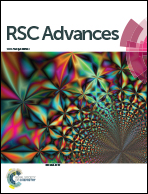Self-assembly, crystal structures and properties of metal–3,4,5-tris(carboxymethoxy)benzoic acid frameworks based on polynuclear metal-hydroxyl clusters (M = Zn, Co)†
Abstract
3,4,5-Tris(carboxymethoxy)benzoic acid (H4TCBA) has been used as a structure-directing agent to prepare three new inorganic–organic hybrid frameworks based on polynuclear metal-hydroxyl clusters, [Zn2.5(OH)(TCBA)(H2O)4]·H2O (1), [Zn2.5(OH)(TCBA)(H2O)] (2), [Co3(OH)2(TCBA)(H2O)4]·2H2O (3) through hydro/solvothermal reactions. The results show that complexes 1 and 2 both own I0O3 hybrid frameworks with a highly-connected binodal 4,8-c network, while 3 reveals a I0O2 hybrid framework with a 3,6-c 2-nodal topology. The multiple coordination system originated from the branching out carboxylate groups in TCBA ligands results in the formation of the multi-stranded helical chains in the high-dimensional metal–organic frameworks of complexes 1–3. The thermal stabilities of complexes 1–3, the photophysical properties of complexes 1 and 2 and the magnetic properties of complex 3 were also investigated. Complexes 1 and 2 emit strong blue light under ultraviolet light, and complex 3 shows typical paramagnetic behavior and an interesting partial spin-crossover has been observed.


 Please wait while we load your content...
Please wait while we load your content...